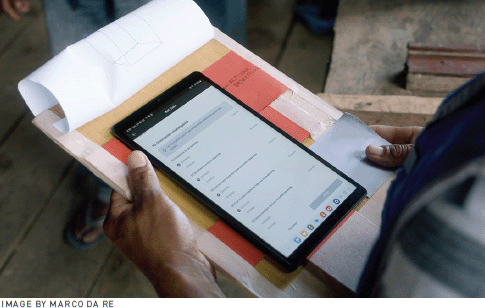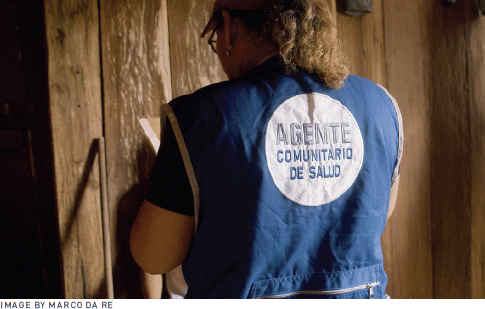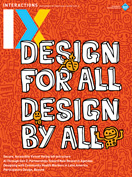Authors:
Fernanda Espinoza, Marco Da Re, Rafael A. Calvo
How do we design for volunteers engaged in helping their own communities? We faced this question while designing a tool to help community health workers (CHWs) collect data from older adults in rural and remote areas of Peru.
→ Culturally sensitive application of self-determination theory improves our design to meet the unique needs of community health workers (CHWs) in Peru.
→ Empowering CHWs through codesign can enhance their motivation to continue improving the health outcomes of their communities.
→ The design of a tool for CHWs must support their basic psychological needs—autonomy, competence, and relatedness—to intrinsically motivate them.
CHWs are an essential part of Peru's health system because they tackle the gaps in healthcare created by the lack of resources in the public health system. CHWs provide care and health information to their communities, serving as the primary connection between families and the health system.
While supporting motivation is at the heart of any technological design, it is particularly important when users are doing difficult, unpaid work and have low computer literacy. Earlier work has shown approaches to supporting online volunteers' motivation [1]. In our case, the worst-case scenario is that technology hinders volunteers' motivation.
The project, funded by the National Institute of Health Research in the U.K., aims to help people in Peru with dementia and their families. The tool we have been designing is a mobile app to be used by CHWs for dementia screening that can evaluate older adults' cognitive and functional abilities. We conducted the community engagement activities discussed here in four different areas in Peru: Lima (capital city), Huancayo (Andes), Tumbes (coast), and Nauta (Amazon rainforest).
 | A community health worker (CHW) in Nauta, Peru. |
To codesign our tool, we combined motivational psychology with design methods in community engagement activities. This consisted of four-day workshops in each site with local facilitators, CHWs, and their supervisors. We followed the same program in each site.
- Day 1: Field researchers explored the site, observing and building rapport with the local facilitators and CHWs.
- Day 2: The research team facilitated training workshops for the CHWs about collecting data from older adults and screening possible dementia cases.
- Day 3: The research team conducted focus groups and codesign activities around the CHWs' work, as well as their their motivation, perceptions, needs, and wants regarding the diagnosis tool and technology.
- Day 4: The CHWs used a prototype of the tool to evaluate an older adult in their community and we conducted semi-structured interviews about their experience.
During the activities, we recorded the conversations and took field notes for subsequent analysis. This was done with deductive thematic analysis of the anonymized transcripts grounded in motivational psychology.
 Understanding Basic Psychological Needs
Understanding Basic Psychological Needs
Our work was grounded in self-determination theory (SDT), which is becoming increasingly popular in the HCI field [2]. SDT argues that users' intrinsic motivation is mediated by three basic psychological needs [3]:
- Autonomy refers to the feeling that one has the power to influence or endorse the outcome of an experience.
- Competence refers to the feeling that one has sufficient ability/expertise relevant to an experience.
- Relatedness refers to the feeling of belonging and connectedness with others (i.e., a secure relational base).
It has been argued that designers should understand what these needs mean for users in a particular context, as well as how technology designs affect them. Guidelines [3] can then be used to design in ways that support the psychological needs.
 Understanding Individual and Community Engagement
Understanding Individual and Community Engagement
SDT allowed us to interpret users' expressions in ways that could be used in an evidence-based design that supports their intrinsic motivation and does not hinder their community engagement.
 | CHWs in Tumbes conducting a check-in with an older adult. |
For example, a community health worker shared her story about her husband's lack of support for her role as a CHW, which hinders her autonomy. The role also makes her feel empowered to have meaningful activities of her own and a sense of competence and mastery by learning about the health issues that affect her community, with whom the role makes her feel more connected. These are specific expressions of the needs of autonomy, competence, and relatedness, all of which need to be supported.
In terms of autonomy, we found that having their own job within the community gave the CHWs a sense of empowerment—autonomy—since they were choosing to spend their time in this role, and it gave them influence on the health outcomes of their communities and their own families. For example, in each region, the CHWs planned their own schedule, dictating which home visits they would do and when they would do them. As designers, we know it's important that they keep that type of control, one that can be easily disrupted by automated calendars and mapping features, which, however, can also help them be more productive.
 | A CHW conducting a cognitive screening of an older adult. |
In terms of competence, CHWs feel challenged in the work they do because every new project is different from the previous one, so they are continually learning. Since they are volunteers with no previous health experience, they receive health training and become informed on the most pressing health issues in their communities. One CHW remarked, "I only learnt about malaria and dengue…. Now I will be teaching not only about dengue or malaria but also about memory and mental issues." They enjoy the challenge of learning new health knowledge and skills for their work. As another CHW said, "I've learnt a lot—a lot of things I didn't know—and I liked it."
We found that having their own job within the community gave the CHWs a sense of empowerment.
In terms of relatedness, the work of a CHW relies on them having a good relationship with the families in their communities. In all sites besides Lima, each CHW had a group of families they continued to work with, dictated by geography. In most cases, CHWs have been volunteering for years and through their regular visits have built long-term trusted relationships within their community. As one CHW said, "We know them, all our families…that we always go see; they know us." It is crucial to support this key aspect of their work through our design since it is one of the main pillars for motivation: "I work without any interests…I do it for the love to my neighborhood, my grandparents, my children," said one CHW. "That is the strength and what gives me the will to keep learning more for them, for me, for the family."
 Understanding Design Strategies for Engagement
Understanding Design Strategies for Engagement
The following step was to understand the design strategies to support the psychological needs of CHWs. We based this on Dorian Peters's work [3] detailing research-based guidelines for supporting psychological well-being in user experience.
The most relevant strategies for supporting CHWs' autonomy include:
- Apply best practices for accessibility. CHWs with varying technological literacy, experience, and physical abilities must be able to access the tool.
- Empathize with the user's frame of reference. Through ongoing user feedback, we can continue to understand CHWs' psychological needs.
- Provide meaningful choices. CHWs can influence their work environment, so they should also be able to influence their digital work environment in order to prevent their autonomy from being obstructed.
- Support informed choices. CHWs need to make informed choices to support their autonomy, so, for example, we should provide clear explanations of the features and settings of the tool.
The most relevant strategies for supporting CHWs' competence include:
 | Prototype of the screening tool for CHWs. |
- Apply best practices for usability. CHWs in different regions of Peru must be able to understand and use the tool. If not, the tool would frustrate their competence and disrupt their motivation to work.
- Provide nonevaluative feedback. CHWs are encouraged to work toward achieving goals (e.g., the number of patients evaluated in a month), so providing informative feedback on their progress in the tool would help them feel accomplished and support their competence.
The most relevant strategies for supporting CHWs' relatedness include:
- Support a sense of meaningful connection to others. This is a key pillar of the CHWs' role and the main support toward their relatedness with their communities. Through our tool, we should enable their connection with others, for example, by providing opportunities for them to connect with older adults, online or offline.
- Support caring for others. CHWs are motivated by the ability to care for their communities, so it is significant that our tool gives them opportunities to do so. For example, the tool could provide CHWs opportunities to share their work with other CHWs and be able to offer support and praise to one another.
Strategies for these design heuristics were applied in the development of our tool.
 | A CHW conducting a screening of an older adult. |
We hope this article encourages fellow designers and research teams to find new ways to prioritize the people they are designing for, seeking a deeper understanding of their motivations and experiences. This is especially critical when designing for vulnerable populations, as we should empower them by listening to their stories and addressing their specific needs.
This case study demonstrates how self-determination theory can be applied to understand users in diverse cultural contexts. We aim to inspire other practitioners to study psychological needs in culturally sensitive ways, ensuring that technology designs support and enhance the intrinsic motivation of users across different communities.
The project was partially funded by the National Institute for Health and Care Research, U.K.: NIHR150287 IMPACT: Innovations using Mhealth for People with dementiA and Co-morbidiTies. We are grateful to the many community health workers and people from the Peruvian communities who make our research possible. We want to acknowledge the work, contribution, and collaboration from all the members of the IMPACT Health Study group that made this research possible. The IMPACT Health project can be followed at https://impact-salud.org/.
1. Naqshbandi, K.Z., Jeon, Y.H., and Ahmadpour, N. Exploring volunteer motivation, identity and meaning-making in digital science-based research volunteering. International Journal of Human–Computer Interaction 39, 20 (2023), 4090–4111.
2. Ballou, N. et al. Self-determination theory in HCI: Shaping a research agenda. CHI Conference on Human Factors in Computing Systems Extended Abstracts. ACM, New York, 2022, 1–6.
3. Peters, D. Wellbeing supportive design: Research-based guidelines for supporting psychological wellbeing in user experience. International Journal of Human–Computer Interaction 39, 14 (2023), 2965–2977.
Fernanda Espinoza is a Peruvian design engineering and research assistant who conducts human-centered and value-sensitive design projects, focusing on projects for underserved populations. She is concerned about responsibly designing technological interventions for positive societal impact. [email protected]
Marco Da Re works as a research and design lead at the Wellbeing Technologies Lab at Imperial College London. He uses human-centered methods to lead end-to-end innovation projects in multidisciplinary teams, focusing on healthcare, climate change, and AI ethics. [email protected]
Rafael A. Calvo is a professor at Imperial College London focusing on the design of systems that support well-being in areas of mental health, medicine, and education, and on the ethical challenges raised by new technologies. [email protected]
 This work is licensed under a Creative Commons Attribution-Noncommercial-Sharealike International 4.0 license.
This work is licensed under a Creative Commons Attribution-Noncommercial-Sharealike International 4.0 license.
The Digital Library is published by the Association for Computing Machinery. Copyright © 2024 ACM, Inc.







Post Comment
No Comments Found